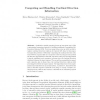98 search results - page 11 / 20 » The Neural Basis for Spatial Relations |
PRESENCE
1998
13 years 7 months ago
1998
This paper considers some rst principles that might provide a basis for an objective science of experience (presence or immersion). Dimensions that are considered include classica...
BC
2002
13 years 7 months ago
2002
The importance of the hippocampus in spatial representation is well established. It is suggested that the rodent hippocampal network should provide an optimal substrate for the stu...
EDBT
2004
ACM
14 years 26 days ago
2004
ACM
Qualitative spatial reasoning forms an important part of the commonsense reasoning required for building intelligent Geographical Information Systems (GIS). Previous research has c...
CORR
2007
Springer
13 years 7 months ago
2007
Springer
Results of neural network learning are always subject to some variability, due to the sensitivity to initial conditions, to convergence to local minima, and, sometimes more dramat...
NIPS
1990
13 years 8 months ago
1990
A new class of data structures called "bumptrees" is described. These structures are useful for efficiently implementing a number of neural network related operations. A...

